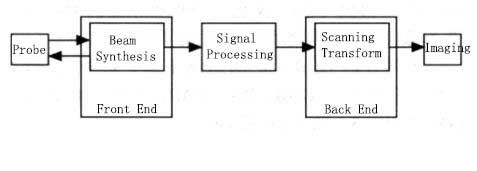The basic components of a portable veterinary sonography machine are shown in Figure 1. The beam synthesizer is called the front end of the portable veterinary sonography machine, and the scan converter is called the back end of the portable veterinary sonography machine. The back end of the sonography machine is always digital, the so-called digital scanning converter DSC, while the front end of the portable veterinary sonography machine can be a digital front end or analog front end. When the portable veterinary sonography machine has a digital front-end, its signal processing part is unavoidably digital signal processing, and the scanning conversion is originally digital, so such a portable veterinary sonography machine is called all-digital portable veterinary sonography machine, as shown in Figure 2. Beam synthesis is simply a delay sum. Delay is to control the direction of the beam and the need to focus, is the essence of the front end of the portable veterinary sonography machine, or even the essence of the entire portable veterinary sonography machine. Delay accuracy is one of the most important indicators of portable veterinary sonography machine, it is to determine the quality of the sound beam and even the core elements of image quality. The complexity of the delay in the reception of dynamic focusing occasions become more prominent, the delay should be received with the increase in depth and real-time dynamic change. Delay method can be divided into two categories: analog delay and digital delay, the use of analog delay front-end called analog front-end, and the use of digital delay front-end called digital front-end. Of course, the front-end circuit also includes the probe interface, transmit and receive amplification.
FIG. 1 Basic composition of ultrasound
FIG. 2 Basic composition of full digital ultrasound
Portable veterinary sonography machine instrument’s basic composition of the whole digital sonography machine’s basic components. Their working relationship is: first by the transmitting circuit transmits sonography pulses, through the probe interface circuit after loading to the probe; probe to receive the echo signal and then through the probe interface circuit back to the receiving amplifier circuit.
Post time: May-20-2024





